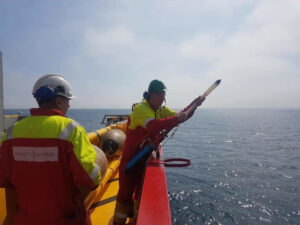The diving methods are various, based on the activities there are SCUBA systems (Self Contained Underwater Breathing Apparatus) devices, which are completely independent of surface supply and used in the recreational, scientific and military sectors; those used in the industrial diving sector such as Surface-Supplied Breathing Apparatus (SSBA), where gas or mixture of gas is supplied from the surface to the diver by a flexible hose (umbilical); the saturation diving stystem which involves divers living and working in an enclosed atmosphere using heliox (helium and oxygen mixture) as breathing gas.
However several diving breathing systems which belong to the SCUBA family, such as rebreathers, are also adopted for saturation diving tasks.
SCUBA systems are classified as Open circuits and Closed circuits:
Open circuit systems – are capable of supplying to the diver compressed gas (air or gas mixture such as Nitrox) contained in a tank, through a regulator in which the diver inhales for physiological needs and exhales directly into the environment.
Closed circuit systems – commonly known as rebreathers, recovers the exhaled gas for re-use. In other words, the exhaled gas is not discharged to waste as in the case of the open circuit, but it is washed of carbon dioxide (the body consumes oxygen and makes carbon dioxide), enriched with oxygen (it adds oxygen to replace what was consumed) and then sent to the diver in the breathing circuit.
In this article, we will introduce to you the components and the use of rebreather during civil and military tasks.
Rebreathers have been used since ancient times, initially breathing in and out inside a waterproof bag to extend the dive time, then for other needs in dry environments such as mines to allow workers to protect themselves from contaminated areas, during World War II to allow divers to carry out raiding tasks in sensitive facilities without being detected.
There are two types of rebreathers, the Semi-Closed Circuit (SCR) with active or passive gas addition mechanisms and fully Closed Circuit Rebreather (CCR) with manual or electronically controlled gas addition. Also on the market are hybrid devices that incorporate more than one mechanism for adding gas.
A Closed-Circuit Rebreather Breathing Apparatus (CCRBA) generally provides a mouthpiece or a fullface mask connected to a flexible tube or hose that carries the breathable gas and an outlet tube or hose that carries the exhaled gas, containing carbon dioxide through a Non Return Valve (NRV) on the mouthpiece to a canister containing a carbon dioxide absorbent, two hoses are connected to a breathing bag. Other important components of the rebreather include a CO2 absorbent cartridge (the duration of the CO2 absorbent cartridge generally corresponds to the capacity of the oxygen cylinder); two high-pressure gas bottles or cylinders, one for a diluent gas and one for oxygen (used to replace the oxygen consumed by the diver to avoid the slow exhaustion of the gas at dangerously low levels (hypoxia)); a microprocessor to control the (PPO2) Partial Pressure of Oxygen (electronic sensors in the breathing loop detect and controls the falling partial pressure of oxygen and activate the oxygen addition valve) and built-in CO2 sensor; manual bypass valves (provide additional oxygen or diluent gas) to the CCRBA; the electronics module which includes computer system, battery and various system controls; audio e vibrator alarms; display mounted on the facemask or Head Up Displays (HUD) allows the diver to monitor the oxygen partial pressure.
CCRBAs intended for military or civilian use for mine clearance or Explosive Ordnance Disposal EOD tasks have a low magnetic and acoustic signature, as Unexploded Ordnance (UXO) could be sensitive to acoustic or magnetic variations and explode.
Paolo Mazzone
SubEng and HSE Adviser
Cover: Special Equipment Company, Genova – Italian Navy
There are three mixtures of oxygen and diluent gases (nitrogen and helium) that are used today for deep diving – nitrogen + oxygen (Nitrox), helium + oxygen (Heliox), helium + nitrogen + oxygen (Trimix)
Partial Pressure of Oxygen – it is the pressure due to the force applied by the volume of oxygen in a gas mixture. It can be calculated multiplying O2 percetage of the mix by the value of its pressure.


